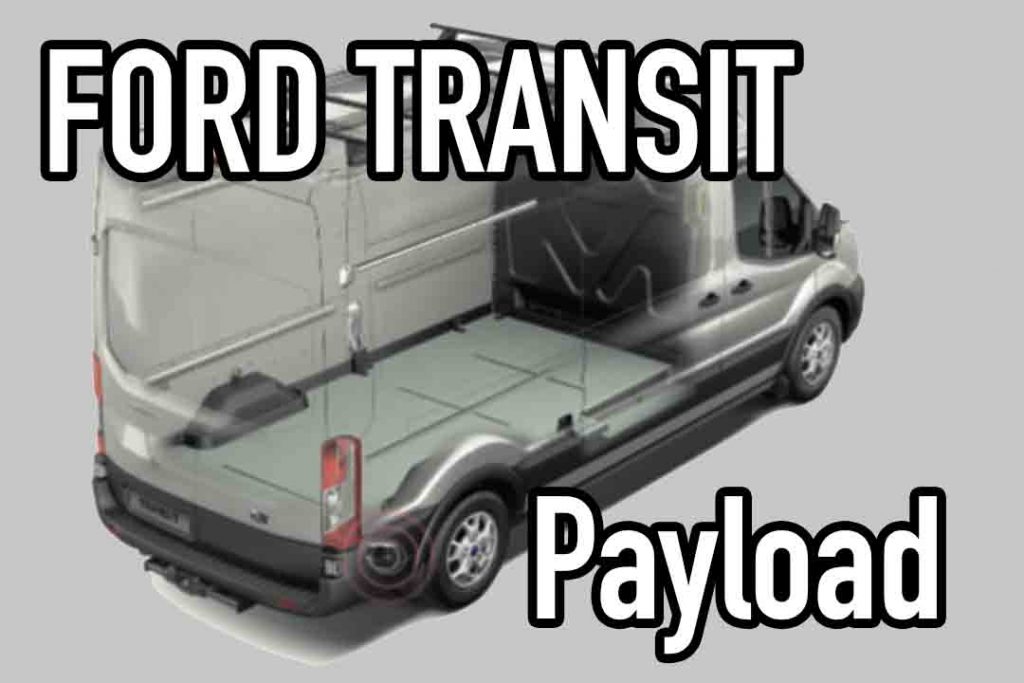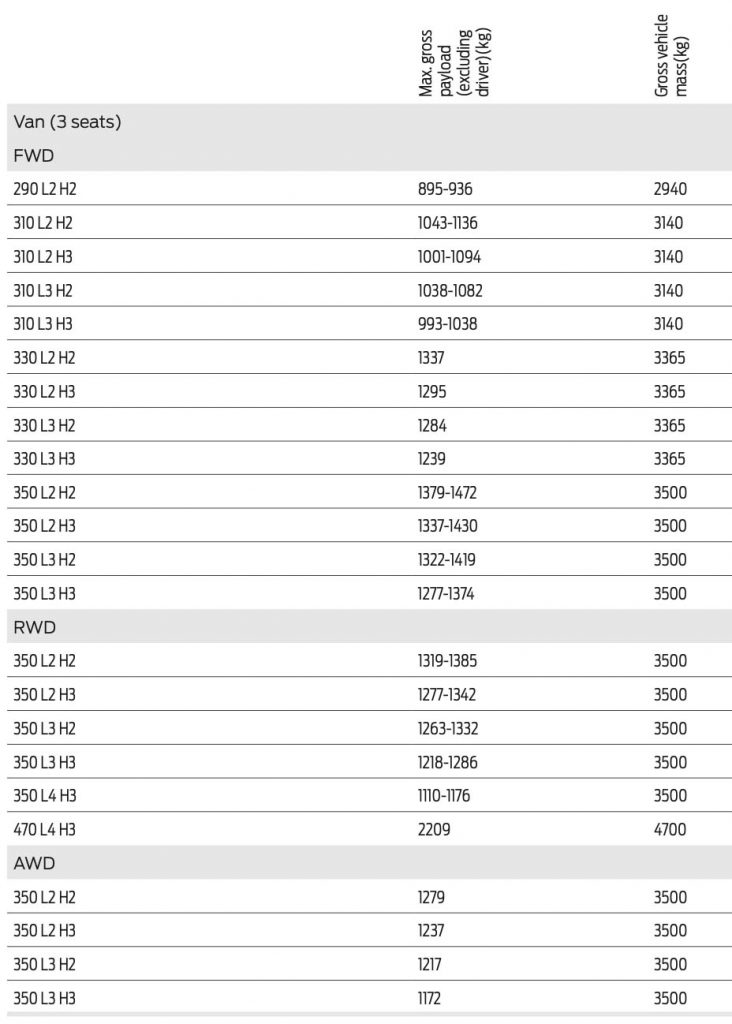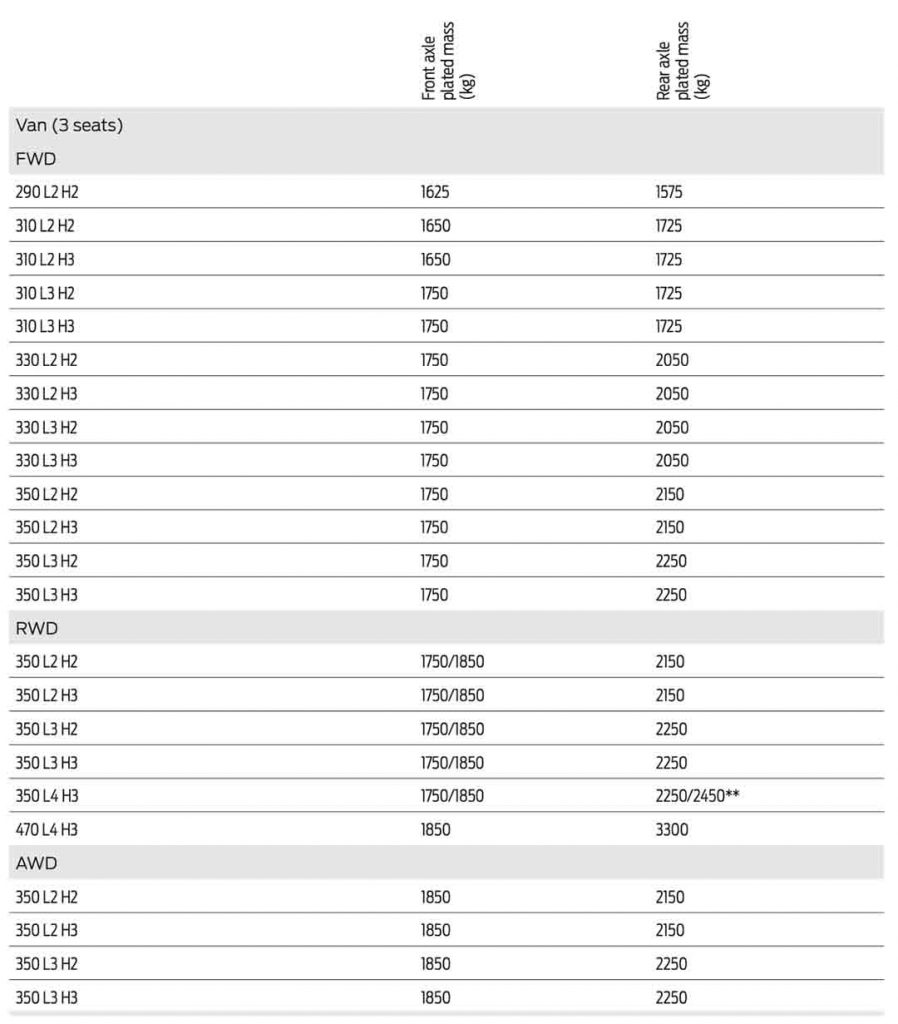
What’s the Ford Transit payload? How much weight can my Ford Transit carry? What’s the Ford Transit van weight?
These are all essentially the same question that you want to know about and you’ve found the right place to get your answers on van payloads.
Take a look at our Ford Transit van weight and payload guide to find out what the payload of a fourth generation Transit is.
The answer is from 1110kg to 1472kg which excludes the weight of the driver but including all necessary fluids and 90% fuel.
If that’s answered your question, great – glad we could help, but its actually a bit more complicated than just a straightforward number.
Most Transit vans are plated (that’s the official term for the legal amount the vehicle and its contents can weigh) at 3.5-tonnes or 3,500kg but you can actually get a Transit van at smaller weight of 2.9-tonnes (2,940kg), 3.1-tonnes (3,140kg) and 3.3-tonnes (3,365kg).
To find out which one you have look at the badge because a 2.9-tonne van is a 290, a 3.1-tonne van is a 310, a 3.3-tonne van is a 330 and a 3.5-tonne van is a 350.
You’ll also see these referred to as T290, T310, T330 and T350.
It’s all logical when you know.
Read our Ford Transit review
Because of the very different plated weights there is a large range of what payload capacity the vans have and how much payload weight your Ford Transit can carry. But, we’ll try to spell it out for you according to Ford’s latest Transit van weight specs.
- Transit 290 has a payload capacity of 895kg to 936kg
- Ford Transit 310 vans get a payload capacity of 993kg to 1136kg
- Transit 330 has a payload capacity of 1239kg to 1337kg
- Transit 350 vans get a payload capacity of 1277kg to 1472kg
That’s the basics and the reason for the wide range is because you can have a Transit van at those weights in a number of different body sizes from short-wheelbase to extra-long-wheelbase. If you want to know more about the Ford Transit dimension take a look at our guide.
The weight of a Ford Transit van depends on the many different driveline versions. The most efficient for payload is the front-wheel-drive van. Below is a table outlining the payload for the Transit FWD vans with their maximum payload as well as the overall weight of a Transit van in the Gross Vehicle Mass column.
| Ford Transit | Max. gross payload - excluding driver (kg) | Gross Vehicle Mass (kg) |
| FWD | ||
| 290 L2 H2 | 895 – 936 | 2940 |
| 310 L2 H2 | 1043 – 1136 | 3140 |
| 310 L2 H3 | 1001 – 1094 | 3140 |
| 310 L3 H2 | 1038 – 1082 | 3140 |
| 310 L3 H3 | 993 – 1038 | 3140 |
| 330 L2 H2 | 1337 | 3365 |
| 330 L2 H3 | 1295 | 3365 |
| 330 L3 H2 | 1284 | 3365 |
| 330 L3 H3 | 1239 | 3365 |
| 350 L2 H2 | 1379 – 1472 | 3500 |
| 350 L2 H3 | 1337 – 1430 | 3500 |
| 350 L3 H2 | 1322 – 1419 | 3500 |
| 350 L3 H3 | 1277 – 1374 | 3500 |
They are also only the numbers for the front-wheel-drive models. If you have a rear-wheel-drive (RWD) or all-wheel-drive (AWD) Transit van you will have a slightly reduced payload because of the added weight and complexity of the driveline.
Rear-wheel-drive vans are only available as Transit 350 models and their payload weight capacity ranges from 1110kg to 1385kg, but as a general rule of thumb they are 80kg to 100kg lower in their payload than the front-wheel drive models. There’s also a Transit 470 with a 4.7-tonne gross vehicle weight (GVW) and payload of 2209kg. The largest Transit van, the Transit 500 has a payload of 2383kg.
The same is true of the all-wheel-drive vans. They drop the payload by 100kg from the front-wheel-drive vans and range from a payload weight capacity of 1172kg to 1279kg.
Take a look at the table below. It will give you all of the Transit van weight spec you need for each panel van variant.

| Ford Transit | Max. gross payload (excluding driver)(KG) | Gross Vehicle Mass (KG) |
| RWD | ||
| 350 L2 H2 | 1319 – 1385 | 3500 |
| 350 L2 H3 | 1277 – 1342 | 3500 |
| 350 L3 H2 | 1263 – 1332 | 3500 |
| 350 L3 H3 | 1218 – 1286 | 3500 |
| 350 L4 H3 | 1110 – 1176 | 3500 |
| 470 L4 H3 | 2209 | 4700 |
Ford is one of the few manufacturers that has introduced a proper all-wheel-drive (AWD) version of the Ford Transit. The AWD Transit payload is less than some of the other versions because of the additional weight of the driven axles. However, all the vans have a top weight gross vehicle weight of 3.5-tonnes. This enables them to have competitive payloads, just slightly less than the RWD equivalent.
| Ford Transit | Max. gross payload (excluding driver)(KG) | Gross Vehicle Mass (KG) |
| AWD | ||
| 350 L2 H2 | 1279 | 3500 |
| 350 L2 H3 | 1237 | 3500 |
| 350 L3 H2 | 1217 | 3500 |
| 350 L3 H3 | 1172 | 3500 |
Aside from the overall payload of the van, another thing to consider is the axle weights of the front and rear axles. This is the individual amount of load that can be on any one axle. Fortunately they are a lot higher than the overall Ford Transit payload of the van, but it doesn’t mean you can’t mistakenly overload an individual axle. Let’s explain…
If you put a pallet weighing exactly one-tonne on the centre of the rear axle, you have added 1000kg of weight to the van. This is accounted for in its overall payload. You’ve also placed weight on both the front and rear axle, as the chassis will distribute the weight across the length of the van. Because it is at the back of the Transit van, however, most of the weight will be on the rear axle. The further back you put that pallet, the more of the weight will be solely on the rear axle.
This is how overloading can happen because not only is the rear axle supporting the 1-tonne pallet it is also supporting the body of the van, the engine, the gearbox and even you and your sandwiches. They all contribute to the final number on the rear axle and what you can legally carry.
The rear axle weight for the Transit 290 is 1575kg. Transit 310 is 1725, Transit 330 is 2050kg and Transit 350 is 2150kg to 2250kg (depending on the body size).
As you can see that’s a lot higher than the payload, ratings but if you were to put the maximum 1472kg of the biggest carrying Transit right at the back of the van – maybe because you loaded it there with a forklift – then you’ve be in danger of being overloaded on that rear axle.
It’s exactly the same scenario with the front axle, but there’s even more to think about because you have the weight of the engine and any occupants to consider.
The front axle weights for the Transit 290 is 1625kg. Transit 310 is 1650kg or 1750kg. Transit 330 is 1750kg and Transit 350 is also 1750kg.
Here’s a look at Ford’s own table of weights and measures for the Ford Transit van weight range. As with the above, this covers the UK Transit models from 2014 onwards.

The most important thing when it comes to carrying weight in your van is to remain on the right side of the law. While we hope our guide is useful and can give you a good indication of how much weight your Transit van can carry the best way to find out how much payload your van has is to check the vehicle plate.
This is a small metal plate (or more commonly now a sticker) usually found on the inside of the driver or passenger side door that lists the GVW, payload and front and rear axle weights. On some occasions you can find it under the bonnet. Our advice... always check the plate.
Overloading your Transit van could get you in seriously hot water. The penalties for overloading a car or van range from a fine to points or even a court appearance.
Not only is it illegal, it will also cause excessive wear on your van and increase the risk of damage, breakdown or even a serious accident.
If the police or the DVSA (Driver Vehicle Standards Agency, formerly VOSA) see you with an overloaded Transit van, above the legal payload they will stop you and prosecute you.
The penalty for exceeding the Transit payload vary according to how much overweight your vehicle is. These are called graduated fixed penalties, get more information on these on the government website.
| Severity | Endorsable | Fixed penalty amount |
|---|---|---|
| Less than 10% | No | £100 |
| 10% up to but not including 15% | No | £200 |
| 15% and over | No | £300 |
You will get a £100 penalty for a 0% to 9.99% overload. But DVSA officials will allow a 5% leeway before issuing a fixed penalty or prohibition. But if you exceed the relevant weight by 1 tonne or more that no longer applies.
Normally, a fixed penalty would be inappropriate for serious cases of overloading. That's when the vehicle is overloaded by 30% and over, or the excess weight is 5 tonnes. Instead a court summons would be issued instead.
Penalties become endorsable - penalty points can be issued - when multiple or severe infrigements are found. How many penalty points for overloading will depend but 3 points is a minimum.
We hope you've enjoyed and found this guide to the Ford Transit van weight and payload useful. Knowing the precise weight of a Ford Transit van and its payload is really important as it will help you to stay on the right side of the law - and as we've mentioned above we know why that's important.
It's not just about the weight of a Transit van, though. Payload can also impact the amount you can tow, so if you're in the habit of loading your van and towing a trailer or caravan, be sure to give our Ford Transit towing capacity guide a read as well.
Published:
Last updated:
